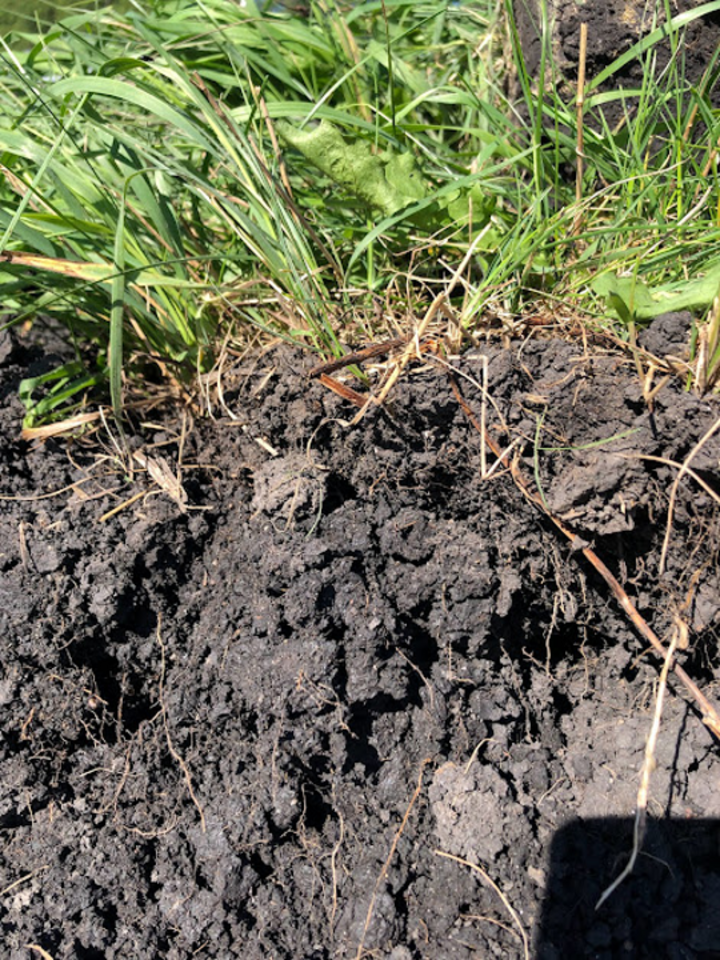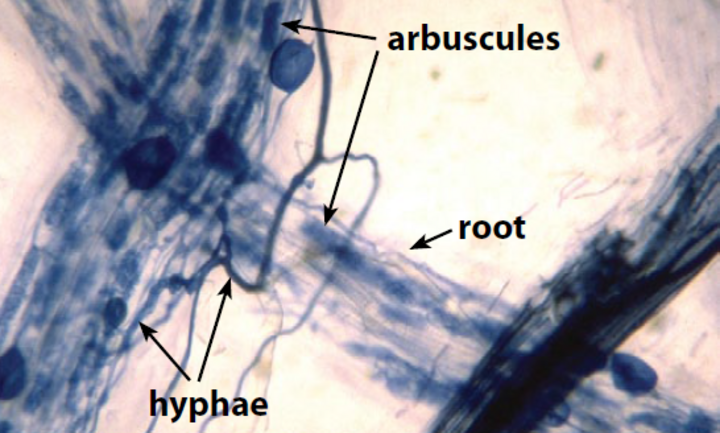What is healthy soil? Most of us can probably look at a freshly dug chunk of soil and intuitively make some assumptions about it. Cues such as a dark color, good earthy smell, crumbly structure, and living roots or organisms like earthworms are simple, informal assessments of a good and healthy soil (Figure 1). But how is healthy soil created? In this article, we explain how plants and soil organisms interact to compose and decompose organic matter, cycle nutrients, and build the structure of soils.

The importance of soils in providing plant nutrients such as nitrogen (N), phosphorus (P), and potassium (K) has long been recognized, but in terms of soil health, it is also critical to think about what feeds soil microorganisms. During photosynthesis, plants take up atmospheric carbon dioxide (CO2) and water to produce glucose. In subsequent chemical reactions, plants synthesize organic molecules such as carbohydrates, proteins and fats from glucose, N, P, K, and other nutrients. While this may seem like basic knowledge, it is important to remember that most other organisms in the soil ecosystem (and other ecosystems), whether microbes, earthworms, cattle, or humans, depend on these plant-derived organic molecules as their food source.
Soils contain thousands of species of organisms, and they all play a role in decomposing plant-made organic molecules. Roots and their exudates, decomposing plant materials, and living and dead organisms in the soil collectively form what we call soil organic matter. The carbon in soil organic matter gives it a rich, dark color. Soil organisms continuously break down organic matter, releasing some nutrients along with CO2 and using some for their own growth.
What specific roles do soil organisms have? Larger ones play roles as grazers and shredders, feeding on and breaking apart plant residues. Some dig and mix soil, or as in the case of earthworms, tunnel through the soil, leaving pores that allow for better air and water flow.
Fungi and bacteria feed on living plants, residues and root exudates, which contain sugars and amino acids and constantly leach out of living roots. Root exudates are a high-quality food for bacteria and fungi, and plants are thought to excrete them to attract microbes, possibly to benefit from their nutrient cycling abilities. In fact, most plants, including crops, have beneficial relationships with fungi that live on or inside their roots.
A well-known example are arbuscular mycorrhizal fungi (AMF), which penetrate plant roots (Figure 2). Their long, threadlike fungi hyphae grow into the soil, and because they are thinner than plant roots, they can access nutrients (especially P) and water in areas that plant roots cannot reach. They transport P and water back to plant roots in exchange for sugars from the plants. This beneficial relationship improves plant nutrition and drought tolerance. Having living roots in the ground year-round that can serve as hosts to AMF increases AMF survival and abundance.

Bacteria are the smallest but most numerous soil organisms. They concentrate around plant roots to feed off exudates, but they also break down other organic matter, usually simpler carbohydrates such as those found in fresh residue. Although the more complex, tough to decompose organic molecules such as lignin from woody plants are decomposed by fungi, some bacteria such as actinomycetes can digest cellulose and chitin — the carbohydrates that make up the cell walls of plants and fungi, respectively. Actinomycetes release an earthy scent that we associate with “good soil”. Some bacteria can fix N from the atmosphere, including Rhizobium species that live in the roots of leguminous plants and free-living ones, such as Azotobacter and Azospirillum.
Predatory microorganisms preying on bacteria and fungi also contribute to nutrient cycling. When protozoa eat other microbes, they release ammonium as a waste product. Nitrifying bacteria — for example, Nitrosomonas and Nitrobacter species — further convert ammonium into nitrite and then nitrate, which can be taken up by plants.
In the process of searching for food, water and habitat, plants and microbes provide structure to the soil. Fungi hyphae and plant roots stabilize soil particles by binding them into aggregates. A mucus-like exudate by AM fungi called glomalin is instrumental in forming aggregates, but many other microbial exudates also function as a sort of glue for soil particles.
Well-aggregated soils have more pores, allowing better air and gas exchange, water infiltration, and water storage. Spaces within aggregates are habitats for bacteria and other microbes. Aggregation can also increase the amount of organic matter in the soil, as organic matter that is bound inside of aggregates is less accessible to microbes and slower to be decomposed.
Having an active, abundant and diverse community of soil microbes will lead to soils where plant residues are decomposed faster, soil structure is improved, and plants are supported by beneficial relationships with microbes. The health of our soils reflects the health of the ecosystem within it.
Resources
Lowenfels, J. and Lewis, W. 2010. Teaming with microbes: The organic gardener’s guide to the Soil Food Web. Timber Press.
Soil Health Institute. https://soilhealthinstitute.org/
